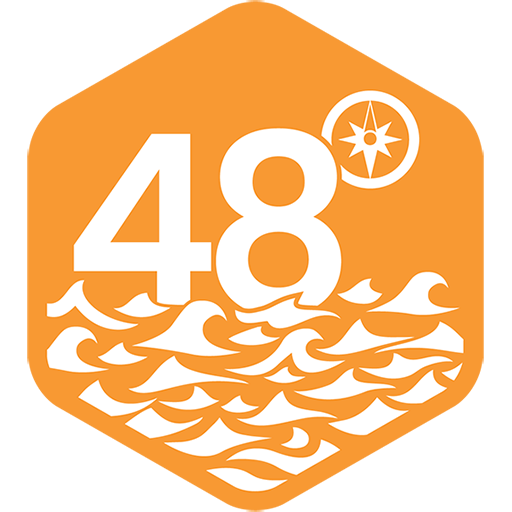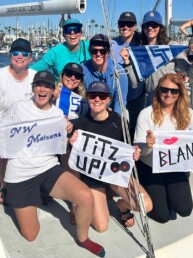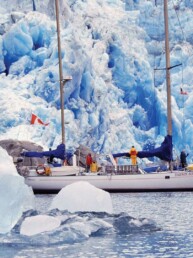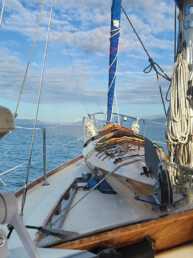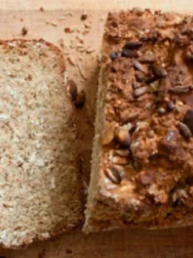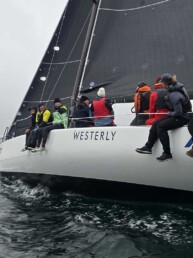With northerly winds, a strong ebbing tide and transient orca sightings, it was a Race to the Straits to remember. Here’s the story from Santa Cruz 27, Norn.
An 8:47 a.m. start on a crisp spring morning marked our third Race to the Straits (RTTS) aboard our Santa Cruz 27, Norn. As always, we joined a hearty chorus of real appreciation for how Sloop Tavern Yacht Club pulls this event together—it’s a remarkably organized operation from the initial horn to the final wrap-up. (And a quick plug: Shannon Renner is looking for volunteers for future races, so if you’re able, consider lending your time!) With 95 boats crossing the start line, RTTS remains one of the high water marks for participation, affection, and enthusiasm on the Pacific Northwest racing scene.
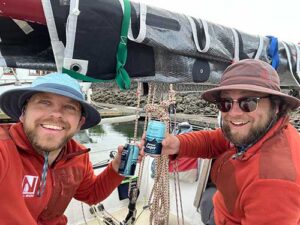
The two-day single or doublehanded event is always a great way to escape the usual Opening Day commotion on Lake Washington; and Puget Sound felt somewhat emptier for it, though the steady stream of commercial shipping continued its relentless pace.
Day one brought racers from Shilshole Bay to Port Townsend, and on day two everyone races the return trip. The chase start applies PHRF handicaps to starting times, so it is a legitimate race to the finish, and the first boat across the line wins.
As any sailor knows, if wishes were fishes, every race would be predictable. But unpredictability is part of the allure, isn’t it? Our previous two Race to the Straits on Norn had certainly delivered variety. The first was a light-air test of patience, pushing the time limits on both legs. The second served up a hearty dose of upwind sailing in 20-plus knots, made more memorable by recovering a crew overboard from a fellow race boat. This year, we were focused on a clean performance, with goals to sail fast, stay out of trouble, have fun, and finish near the front of our fleet both days.
Day One: The Hunt for Breeze and the Point No Point Shuffle
Saturday’s start offered light and shifty conditions, a classic morning Salish Sea scenario. We hoisted kites, diligently working to connect the patches of subtle cat’s paws on the water. Soon enough, a northerly filled in, shifting the game to an upwind beat in light-to-medium pressure. We made a tactical decision to play the middle of the Sound, hoping to benefit from the ebb tide. However, without other boats nearby for a reliable speed comparison, a run-in with a patch of kelp on the keel initially felt like a strategic blunder. After a quick back-down maneuver to clear the speed brake, we were back in the thick of it. It’s a good reminder that sometimes you just have to deal with the hand you’re dealt. The J/111 Hooligan made a similar recovery later and went on to take first across the line that day.
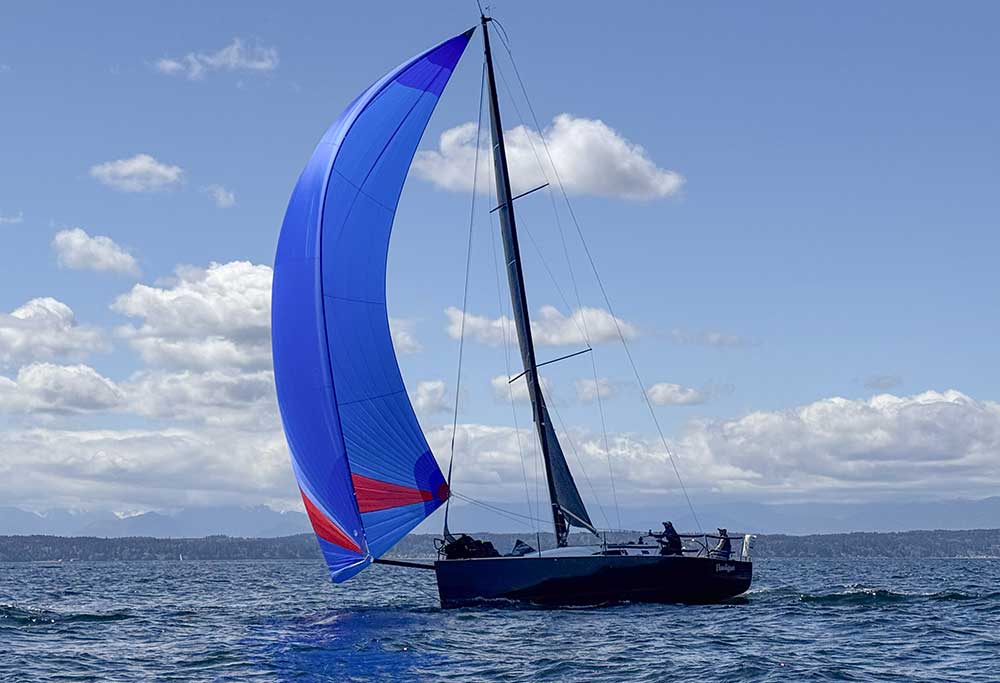
As it so often seems to during Race to the Straits, the wind began to fade as we approached Point No Point. Before long, the fleet looked more like a collection of toy boats drifting in positive ebb current reaching between 2 and 4 knots in places.
This seemed manageable until the geometry of the course became a pressing issue—we were on the west side of the Sound, with the mid-course gate to our east. Progress was a slow, sideways affair. Thankfully, boats farther north served as canaries, signaling the challenging conditions. A few of the leaders managed to punch through the gate at Double Bluff, while others, caught by the adverse current, had to hoist spinnakers and actively sail south against the flow..
The northbound leg from there was a slow burn for about an hour. Some crews seemed content to point their bows generally towards Port Townsend with minimal sail adjustment, while others were in constant motion, trimming for every fraction of a knot. It’s always hard to say which approach nets out better in those tricky transitions. Adding to the morning’s sights, a pod of transient orcas passed through, seemingly leading the fleet toward better fortunes. And then, as if on cue, a fresh west-northwesterly breeze materialized, quickly building to a lively 12-18 knots. Given our sail inventory, we stuck with the J3, while many other boats, now close to the finish, held onto their bigger J1s heeling hard and doing all they could to keep it together without a full crew on the rail as ballast at the top of the range for that type of sail. The fleet began to compress, leading to a tight group finishing in Port Townsend around 3 p.m.—our earliest Race to the Straits finish to date. Forty two of the 95 boats finished within 10 minutes before or after our finish! With drinks in hand, we enjoyed a classic Port Townsend sunset, and toasted a great day that left us at the top of our class for the time being. A big thank you to the event organizers for a fantastic shoreside gathering with incredible BBQ and camaraderie.
Day Two: Downwind Runs, Orca Encounters, and a Satisfying Finish
Sunday morning greeted us with the same west-northwest breeze that had blown consistently through the night. We hoisted the S2 spinnaker almost immediately off the starting line and enjoyed a spirited run, sailing alongside the other modified Santa Cruz, Banana Stand, sailed by a great father-son team. More orca sightings added to the day’s experience on the southbound leg.
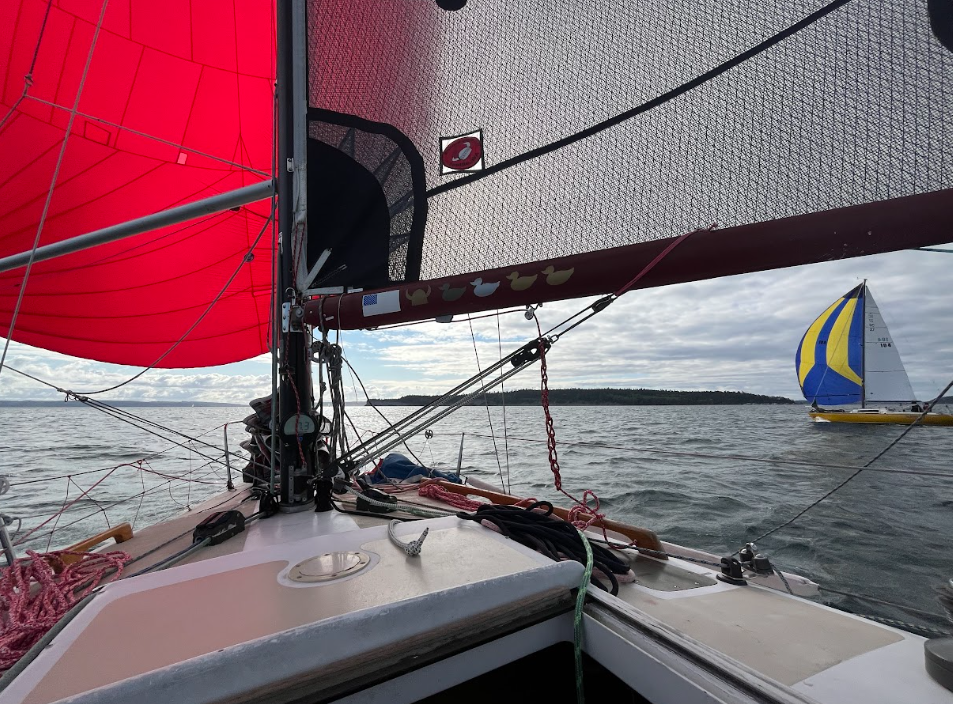
The breeze moderated as we neared the halfway point, same as the day before, but conditions remained delightful—flat water close to shore and a pleasant 8-10 knots of breeze. Crossing back to the west side of the Sound at Point No Point, we found ourselves in a competitive pack of 12-15 boats, all jockeying for position. Among them were familiar faces like the Olson 25 Three Ring Circus, Peterson 34 Tonic, as well as our class competitors on the Pt. Bonita 27, Pell Mell.
It was at this point we had one of those classic sailing realizations: we were working hard, jibing frequently near shore in good breeze, fighting to maintain 4-5 knots of progress toward the finish. Yet, just the day before, in similar conditions, we could have pointed the boat towards Port Townsend, hardly touched the sails, and achieved similar speed. Sailing with, not against, the conditions certainly has its advantages; and in this region the current can be as big a factor as the wind.
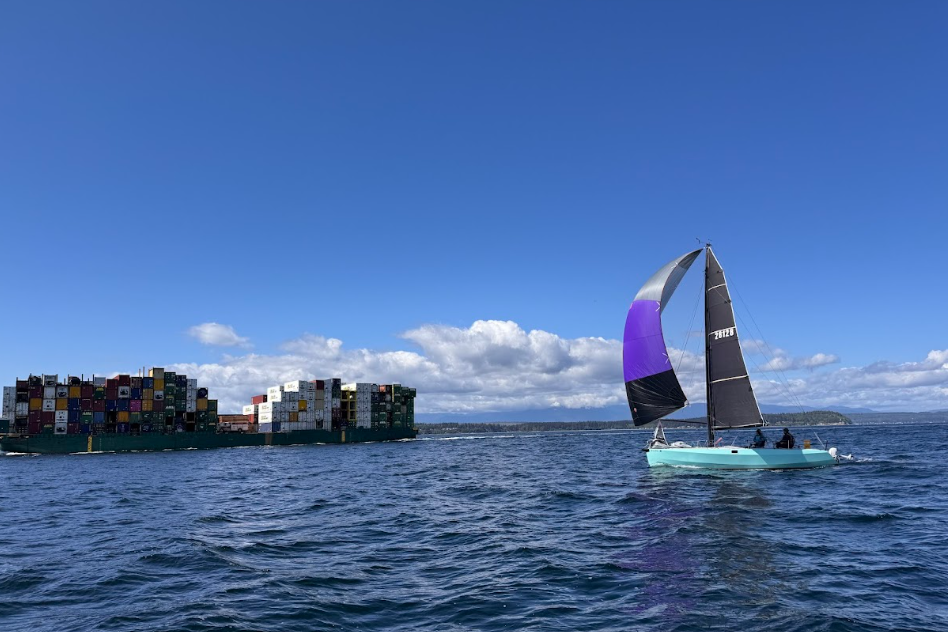
A lively duel with Three Ring Circus developed as we made our final approach to Shilshole. And again, the visual was impressive—nearly 90 boats converging within a few miles of each other, a ballet of cross-jibing sails. Friends on the Paul Bieker Tri-nado Humdinger, G32 catamaran Incognito, and the J/111 Hooligan were all part of this dynamic fleet, drag racing towards the finish. All manner of multi and monohulls jibing and making close crosses right to the last. It’s a unique thrill to see boats of all shapes and sizes coming together at the culmination of a long run down from Port Townsend.
With all that variety and speed potential, it was the well sailed Westsail 32, Hula, who was the first across on this fine RTTS Sunday.
We crossed the line among the top boats, feeling a deep sense of contentment. This was our first Race to the Straits without any major setbacks or retirements, a milestone in itself. And we were very pleased to finish the weekend at the top of our class, closely followed by Express 27 Thumper and Pell Mell. The overall win for the weekend went to Tonic, who shared the overall podium with Hooligan and Humdinger.
It was fantastic to see so many friends and fellow competitors out on the water, enjoying the challenge of shorthanded sailing in the Pacific Northwest. We’re already looking forward to next year’s edition.
Full results at: race.styc.org
Feature photo courtesy of Sean Trew.
